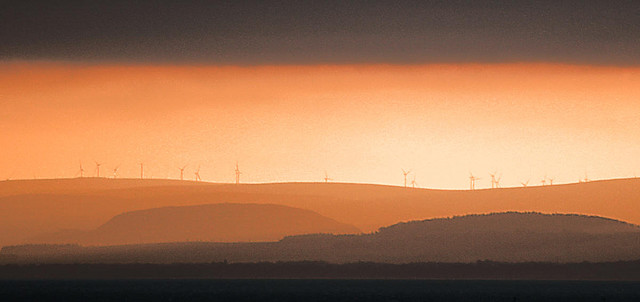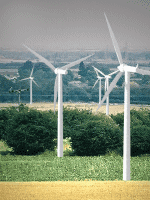by Jeff Siegel, Energy & Capital
Those on the right are blasting it as a treehugging boondoggle. Those on the left are praising it as an opportunity to diversify the state's energy portfolio. And those looking to profit yet again from the transition of our global energy economy are sniffing out the money trails.
The latter is where we'll focus our energy today.
Waiting on the Free State
Earlier this year, Maryland Governor Martin O'Malley reintroduced offshore wind legislation that would've ultimately led to the construction of more than 80 turbines off the coast of Ocean City.
A couple of weeks ago, it passed the House. But stiff opposition kept it from coming to a vote before the Senate Finance committee.
Those who opposed the bill were unhappy with the proposal that called for ratepayers to pony up an additional $1.50 a month to help pay for the wind farm. That fee would've been tacked on once the farm went online – which would've been around 2017.
However, most surveys have found that more than half of Maryland ratepayers actually support the plan – even with the $1.50 monthly fee. The most recent survey showed 62% of those polled back the legislation. And I suspect that despite some angry message board posts and a handful of fear-based political ads, support for offshore wind in Maryland will not go gently into that good night.
Although this will take time, I have little doubt that within the next few years, an offshore wind bill will finally get approved. And when that happens, I definitely look forward to finding out which turbine and transmission companies will land the big deals.
My money's on ABB (NYSE: ABB), Siemens (NYSE: SI) and Gamesa (PINK SHEETS: GCTAF), which last year launched the Offshore Wind Technology Center in Chesapeake, VA with Northrop Grumman (NYSE: NOC). Northrop's looking for a piece of the offshore wind business as it could offer a big boost for the company's ship building arm.
Of course, Maryland's eventual expansion into the offshore wind space will still only represent a very small portion of the overall offshore wind market.
But about 3,600 miles to the east, it's a completely different story.
European Windstorm
According to Pike Research, offshore wind growth is expected to soar over the next five years. In fact, the firm has suggested offshore wind power production will reach $104 billion in revenues by 2017. This is a 53% annual growth rate based on 2011 revenue numbers.
Much of this growth – about 75% – will come from Europe.
In the UK, offshore wind energy development is strong. A recent government report actually shows that offshore wind could account for as much as 50% of the total electricity in the United Kingdom by 2050.
Denmark currently has about 4,000 megawatts of wind power capacity installed (which covers about 20% of the nation's electricity needs), and a few weeks ago approved an additional 1,000 megawatts of offshore wind that's expected to be online by 2020.
Germany actually has plans to have 10,000 megawatts of offshore wind sending juice to its grid by 2020, and 25,000 megawatts by 2030. This is massive, and to put that in perspective, Maryland's looking to add – at most – 500 megawatts.
Now if you're a regular reader of these pages, you know that Germany's in the process of transitioning to a nuclear-free energy mix, of which 80% would come from renewable sources by 2050. This is truly an aggressive goal that, if met, could singlehandedly alter the face of renewable energy investment in the future.
Certainly Germany accomplished this once already by turning the once-niche-based solar industry into a multi-billion-dollar powerhouse.
I wouldn't bet against Germany falling short on its goals.
France also recently dipped its toes into these waters.
Last week, government officials in France finally decided which companies would be selected to build 3,000 megawatts of offshore wind. State-owned EDF, in partnership with Alstom (PINK SHEETS: AOMFF) won most of the deals with Iberdrola (PINK SHEETS: IBDRY) of Spain picking up a fourth deal.
Interestingly, this news came about a month after the Court of Auditors in France published a report that revealed the cost of producing nuclear energy is set to surge as old plants need updating and new safety standards will be put in place. The court suggested that nuclear will require significant investment in the short- and medium-term at a rate of at least double the current level of investment.
Best Green Stocks Quarterly - FREE Investing Newsletter!!!
Pucks N Ponies Free Picks - LIVE Outsiders
Popular Posts
-
Here are some clean power penny stocks to consider accumulating positions in during the current market weakness, with an expectation of sel...
-
Top Global Wind Power Companies Alphabetical list of major publicly-listed wind energy stocks: A-Power Energy Generation Systems, L...
-
Publicly-listed Windpower Companies and Suppliers AAER Wind Energy (TSX-V) Canadian windpower stock Acciona Windpower (ANA.MC) AeroVironment...
-
If we are going to transform this planet into a sustainable, infinite energy powered living macine, then Rare Earth Elements will continue t...
-
Rare Earth Minerals stocks, investing in Rare Earth Elements Here is a list of publicly-traded Rare Earth Elements stocks: Alkane Resource L...
Wind Energy Investing Links
Green Mutual Fund Investing Info
Rare Earth Stocks Research
O Joe College Blog
Twitter / BestGreenEnergy
21st Century Architecture
Best Green Stocks Investing Blog
Monday, April 16, 2012
Monday, April 2, 2012
Canada's dysfunctional electricity system costs Canadians dearly
Provincial isolationism creates pollution and drives up costs
by Barrie McKenna, The Globe and Mail
The oil sands’ big carbon footprint is a source of much national angst.
It stirs East-West rivalries, riles environmentalists and sours relations with some trading partners.
A lot less attention is paid to Canada’s hopelessly inefficient and highly politicized electricity business. That’s unfortunate, and costly.
The fragmented market wastes billions of dollars every year and produces millions of tonnes of extra greenhouse-gas emissions, according to Pierre-Olivier Pineau, associate professor at the University of Montreal’s HEC business school and author of a new study, Integrating Electricity Sectors in Canada: Good for the Environment and for the Economy.
“We could save money and reduce our carbon emissions,” Prof. Pineau said in an interview. “But politically, it’s difficult.”
No kidding. Provincial monopolies, powerful entrenched bureaucracies and regional jealousies have created a balkanized energy system that serves the few at the expense of the national interest.
Consider Quebec and Ontario. Three-quarters of Quebeckers heat their homes with electricity, generated from a vast network of hydroelectric dams.
Meanwhile, Ontario is ramping up production of electricity made from natural gas and subsidizing purchases of wind and solar power as it scrambles to shut down dirty coal-fired capacity.
Here’s the catch: Hydroelectricity is a wonderful and clean source of energy, but not a very efficient heat source. Natural gas, on the other hand, is a great source of heat, but an inefficient way to make electricity.
In essence, Quebec is force-feeding wasteful hydro consumption with low electricity rates, and Ontario is paying too much and polluting more because it can’t buy enough cheap and clean hydro, Prof. Pineau argues.
In a more rational economic world, Quebec would use inexpensive and abundant natural gas to heat homes. And Ontario would buy more hydro power from neighbouring Quebec or Manitoba to power its factories.
“[Hydroelectricity] … should be shared, as with other energy sources and other consumer goods, according to economic criteria,” Prof. Pineau says in his study, published by Federal Idea, a Montreal-based think tank. “In other words, discrimination based on their province of residence must stop, to allow production companies to sell to the highest bidder.”
Hydro-Québec isn’t alone. The other hydro-rich provinces – British Columbia and Manitoba – operate in a similar fashion, selling cheaply to local consumers, rather than offering that power to other provinces.
The misallocation of gas and hydro resources isn’t the only costly anomaly in Canada’s electricity landscape. Quebec and Ontario overspend to produce wind power, creating an underused backup to other sources of supply. If Canadian utilities were serious about wind power, they would instead join forces to build vast wind farms where it makes the most economic and climatic sense – the Saskatchewan prairies.
Then there’s Newfoundland. Still stinging from the perceived bad deal it made decades ago to sell all the power from Labrador’s Churchill Falls project to Hydro-Québec, the province now wants to tap the Lower Churchill River’s hydro potential. The best way to get the power out, of course, is through Quebec.
But Hydro-Québec is apparently demanding too steep a transmission price. So Newfoundland is planning to reroute the power via a costly and circuitous subsea cable back to the island, across to Nova Scotia, and eventually to markets in New England. Only a federal subsidy makes the $6.2-billion megaproject feasible.
Newfoundlanders could wind up paying dearly for power they don’t really need.
Last year, heavily indebted New Brunswick came close to selling Crown-owned New Brunswick Power Corp. to Hydro-Québec. But the deal fell apart, at least partly because of bruised provincial pride. While deeply unpopular with ordinary New Brunswickers, the takeover was economically and environmentally sound. Quebec would get a new market for its cheap hydro, allowing New Brunswick to curb its use of oil and coal for generating electricity.
Instead of cheaper rates, New Brunswickers will pay more and pollute more.
And so it goes. Provincial electrical utilities operate in a strange netherworld. They compete in a free market of deregulated oil-and-gas markets, and cross-border electricity markets. But at home, they’re slaves to provincial mandates and political pressures.
There’s plenty of opportunity for the provinces to co-operate. Too often they don’t, and Canadians are paying a steep financial and environmental price as a result.
It’s no way to make sensible national energy policy. Maybe environmentalists should get a little more exercised about inefficiencies in electricity markets, and lay off the oil sands.
by Barrie McKenna, The Globe and Mail
The oil sands’ big carbon footprint is a source of much national angst.
It stirs East-West rivalries, riles environmentalists and sours relations with some trading partners.
A lot less attention is paid to Canada’s hopelessly inefficient and highly politicized electricity business. That’s unfortunate, and costly.
The fragmented market wastes billions of dollars every year and produces millions of tonnes of extra greenhouse-gas emissions, according to Pierre-Olivier Pineau, associate professor at the University of Montreal’s HEC business school and author of a new study, Integrating Electricity Sectors in Canada: Good for the Environment and for the Economy.
“We could save money and reduce our carbon emissions,” Prof. Pineau said in an interview. “But politically, it’s difficult.”
No kidding. Provincial monopolies, powerful entrenched bureaucracies and regional jealousies have created a balkanized energy system that serves the few at the expense of the national interest.
Consider Quebec and Ontario. Three-quarters of Quebeckers heat their homes with electricity, generated from a vast network of hydroelectric dams.
Meanwhile, Ontario is ramping up production of electricity made from natural gas and subsidizing purchases of wind and solar power as it scrambles to shut down dirty coal-fired capacity.
Here’s the catch: Hydroelectricity is a wonderful and clean source of energy, but not a very efficient heat source. Natural gas, on the other hand, is a great source of heat, but an inefficient way to make electricity.
In essence, Quebec is force-feeding wasteful hydro consumption with low electricity rates, and Ontario is paying too much and polluting more because it can’t buy enough cheap and clean hydro, Prof. Pineau argues.
In a more rational economic world, Quebec would use inexpensive and abundant natural gas to heat homes. And Ontario would buy more hydro power from neighbouring Quebec or Manitoba to power its factories.
“[Hydroelectricity] … should be shared, as with other energy sources and other consumer goods, according to economic criteria,” Prof. Pineau says in his study, published by Federal Idea, a Montreal-based think tank. “In other words, discrimination based on their province of residence must stop, to allow production companies to sell to the highest bidder.”
Hydro-Québec isn’t alone. The other hydro-rich provinces – British Columbia and Manitoba – operate in a similar fashion, selling cheaply to local consumers, rather than offering that power to other provinces.
The misallocation of gas and hydro resources isn’t the only costly anomaly in Canada’s electricity landscape. Quebec and Ontario overspend to produce wind power, creating an underused backup to other sources of supply. If Canadian utilities were serious about wind power, they would instead join forces to build vast wind farms where it makes the most economic and climatic sense – the Saskatchewan prairies.
Then there’s Newfoundland. Still stinging from the perceived bad deal it made decades ago to sell all the power from Labrador’s Churchill Falls project to Hydro-Québec, the province now wants to tap the Lower Churchill River’s hydro potential. The best way to get the power out, of course, is through Quebec.
But Hydro-Québec is apparently demanding too steep a transmission price. So Newfoundland is planning to reroute the power via a costly and circuitous subsea cable back to the island, across to Nova Scotia, and eventually to markets in New England. Only a federal subsidy makes the $6.2-billion megaproject feasible.
Newfoundlanders could wind up paying dearly for power they don’t really need.
Last year, heavily indebted New Brunswick came close to selling Crown-owned New Brunswick Power Corp. to Hydro-Québec. But the deal fell apart, at least partly because of bruised provincial pride. While deeply unpopular with ordinary New Brunswickers, the takeover was economically and environmentally sound. Quebec would get a new market for its cheap hydro, allowing New Brunswick to curb its use of oil and coal for generating electricity.
Instead of cheaper rates, New Brunswickers will pay more and pollute more.
And so it goes. Provincial electrical utilities operate in a strange netherworld. They compete in a free market of deregulated oil-and-gas markets, and cross-border electricity markets. But at home, they’re slaves to provincial mandates and political pressures.
There’s plenty of opportunity for the provinces to co-operate. Too often they don’t, and Canadians are paying a steep financial and environmental price as a result.
It’s no way to make sensible national energy policy. Maybe environmentalists should get a little more exercised about inefficiencies in electricity markets, and lay off the oil sands.
Subscribe to:
Posts (Atom)
Find Green Stocks, Ethical Investing Search Engine

Custom Search



